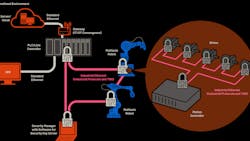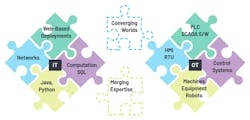The fourth Industrial Revolution (Industry 4.0) is changing the way products are created by spreading digitized manufacturing/processing and automation. We have seen the benefits of automation over decades and are now adding enhanced data, machine learning and artificial intelligence to the mix. Today, autonomous systems are more interconnected, communicating, analyzing and interpreting data to let managers intelligently decide and act in other areas of the factory.
Smart factory initiatives create business value by increasing output, asset utilization and productivity. They leverage new data streams to improve flexibility and quality while reducing energy consumption and waste. Increasingly, edge-to-cloud connected networks let factories increase efficiency through mass customization.
The goal of Industry 4.0, much like IIoT, is to increase the amount of usable data and improve decision making. Timely access to data and its delivery depends on networks. Networking technology, along with manufacturing processes and methods, must advance to handle more data. Intelligent, interconnected automation requires connected machines collecting and sharing information. How these machines and factory communicate through networks makes Industry 4.0 possible.
The need for seamless connectivity from every sensor and actuator across the factory, even those in remote locations, is impossible within the existing infrastructure. The challenge is finding how to handle unprecedented volumes of data without crippling the communication network designed to transmit it. This raises the question of how to build and deploy industrial communication networks to meet the needs of today’s automation environments and tomorrow’s virtual factory floors.
Why Deploy Industrial Ethernet?
Connectivity is central to Industry 4.0, but three things must happen before there are truly connected companies. First, higher-level information technology (IT or enterprise infrastructure) must merge with the plant floor operational technology (OT and the control network). Secondly, manufacturing cells on factory floors must interoperate. Thirdly, there must be seamless, secure connections from the edge of the process to the cloud.
To address these challenges, industry must adopt networks that support interoperability, expandability and reach. Ethernet seems ideal, being well understood and widely used in most factories. It also has high bandwidth and can be put in place relatively quickly.
However, Ethernet is not suited for industrial control given the need for real-time operations. Control networks must send information where and when it is needed to ensure the tasks are processed correctly. The TCP/IP protocol for routing traffic does not guarantee this level of performance. In the same way standard Ethernet lets users share files and access network devices such as printers, Industrial Ethernet lets controllers access data and send instructions from PLCs to sensors, actuators and robots on the factory floor.
The key difference between the two is the impact of delayed and undelivered messages. In non-real-time applications, if the webpage updates too slowly, effects are minimal. In manufacturing environments, however, effects can be more harmful—from wasting materials to injuring workers. For control systems to work, messages must get to their destinations reliably and on time, every time.
As a result, Industrial Ethernet has emerged as the technology of choice at the control level of the operating technology. The goal is to connect IT and high-level operation networks, as well as connecting the layers of the factory’s operations network to end-node sensors and actuators (see illustration below).
Today, complex, power-hungry gateways are required to connect manufacturing cells to Ethernet at higher layers where the converged IT/operational technologies are required. Having a plant-wide, interoperable automation network based on Ethernet would eliminate the need for these gateways, thereby simplifying the network.
In fact, protocol gateways that translate and connect to the operational network’s upper layer are not directly addressable and create information isolation within the network. This data isolation limits the ability to share information across the factory . This is contrary to a vision of Industry 4.0 in which manufacturers want to collect telemetry data from the operational side to drive analytics and business processes on the IT side.
Control applications need predictability in packet delivery and timing guarantees. So, many vendors tried to provide real-time protocols for operational networks. This resulted in solutions that, while predictable, were specific to each vendors’ protocol. This, in turn, led to lots of different incompatible communication protocols running in different manufacturing cells. This perpetuates data isolation, or data islands. Different manufacturing cells running different protocols must share the network in a way that guarantees control traffic is not compromised.
The answer is time sensitive networking (TSN), a vendor-neutral, real-time Ethernet standard based on the IEEE 802.1. As the name implies, TSN focuses on time. It transforms standard Ethernet communication into a process that guarantees timing for mission-critical applications. It makes sure information moves from one point to another in a fixed and predictable amount of time. This is how TSN guarantees timely delivery.
For communications to be predictable, network devices must share a concept of time. The standard defines how to transmit certain TSN Ethernet frames on a schedule, while letting non-TSN frames be transmitted on a best-effort basis. This is how TSN handles real- and non-real-time traffic on the same network. All devices share the same time, so data can be transmitted with low latency and jitter at gigabit speeds.
The goal is a converged network, where protocols each share the wire predictably and reliably. TSN’s tools provide the predictability. It represents the transition to a reliable and standardized connectivity architecture, eliminating data isolation through proprietary fieldbuses. This convergence of networks will drive data generation through the network’s growing scalability across bandwidths from 10 Mbps to 1 Gbps and beyond.
The likely scenario is that TSN will be adopted throughout new installations, but incrementally in cells or segments within facilities. For field-device manufacturers, this means Industrial Ethernet and TSN must be supported for the foreseeable future.
Connecting the Entire Enterprise
Our final and perhaps most important change is building seamless connectivity from the edge node to the enterprise cloud in process control applications (see graphic below).
To date, connectivity to the edge has been limited by the 4-mA to 20-mA or fieldbus technologies. These hardwired point-to-point connections restrict the network ‘s flexibility to grow and change over time.
These non-Ethernet-based communications face several challenges. First, bandwidth such as 1.2 kbps for HART on 4-mA to 20-mA limits information flow’s amount and speed. Second, limited power delivery to the instrument restricts is functionality. Finally, the gateways at the control and IT level are an unsustainable overhead. There is also the challenge of operating in intrinsically safe Zone 0 and using existing cabling network to support faster, less-expensive commissioning.
These challenges necessitated development of IEEE 802.3cg-2019, a standard for 10BASE-T1L, full-duplex communication. It was recently approved and specifies 10 Mbps full-duplex communication with power over a single twisted-pair cable up to 1-km long.
Data starts in the sensor as an Ethernet packet and goes to the operational network and IT infrastructure as an Ethernet packet. There is no need for translation, which creates delays and costs, and consumes power. Existing networks will change, with remote I/O units going to Ethernet field switches.
Ethernet instructions can be sent to and from the controller through 10BASE-T1L multiport field switches to and from field instruments. Insights generated at field nodes can be sent via Ethernet packets (with higher bandwidth) through the field switch network to PLC/DCS controllers and, ultimately, to the cloud.
Several advantages will drive the move from legacy fieldbuses to Industrial Ethernet. First, the potential to reuse existing cabling (up to 1 km in length) simplifies deployment and reduces retrofitting costs. Second, power delivered over the cable to the equipment was confined to 36 mW (best case, with 4 mA to 20 mA deployments). It will be free to go up to 60 W (cable dependent) or 500 mW in Zone 0 applications.
The extra power lets equipment handle higher functions with end node intelligence. This, and the 10 Mbit uplink speed now available, will provide increased insights in how to capitalize on Industry 4.0’s promised efficiencies.
What’s Available Now?
Durable, low-latency, low-power equipment with scalable switching is needed for automation networks to advance. To support next-generation applications, Industrial Ethernet-manufacturers are developing silicon and software to ensure time-critical data is reliably delivered throughout industrial applications. For example, ADI Chronus from Analog Devices provides embedded switches and multiprotocol software that are fully tested and verified for fast times to market.
- Notable solutions within Chronous include: 10 Mbps/100 Mbps Industrial Ethernet PHY with improved features and durability.
- The lowest latency, lowest power gigabit PHY that withstands harsh environments. The fido5200/fido5100 a real-time, embedded, two-port, multiprotocol switch that supports many TSN features.
- New TSN features can be added via firmware updates that become available. Multiprotocol software updates are also supported and available through the developer’s portal.
To support the transition and provide a bridge to legacy field devices, a software configurable I/O (AD74413R) from Analog Devices lets users develop field-configurable remote I/O units that handle communications between legacy machines and higher- level Ethernet networks.
What About Security?
Ethernet has vulnerabilities, and security is a critical one that is slowing adoption of Industry 4.0. With an open flow of an enterprise’s information between operational networks and IT and from the edge to the cloud, the aftermath of security breaches could be devastating.
Security should be a fundamental risk-management concern in planning an Industry 4.0 strategy. Building security into increasingly complex networks is not easy. It must be a multilayer approach that makes its way through the entire system—within edge devices, controllers, gateways and further up the stack. With silicon and software becoming available, OEMs can offer security at each node point in the system while minimizing trade-offs in power, performance and latency.
The Roadmap to Deployment
Although Industrial Ethernet has seen considerable growth in recent years, fieldbuses and other legacy networking technologies are still being deployed. The advantages of converged networks based on Industrial Ethernet include a simplified network architecture, cost reduction by removing gateways, improving system optimization and increasing up-time. The advent of new standards and their imminent ratification is the catalyst needed to accelerate this awaited transition.
This is a transition firmly driven by the need for better-performing connectivity networks with increased integration between OT and IT. TSN is the vehicle to deliver a converged network and, when married with 10BASE-T1L, will enable seamless edge-to-cloud connectivity. The migration will not happen overnight, but the potential benefits are so compelling that it is likely adoption will outpace standard industrial norms.
At the heart of the Industry 4.0 vision is the ability to automate processes using connected devices with the capacity to collect, send and receive information. New technology is unlocking the data and insights previously unobtainable from many edge-node devices. It is opening the doors to better data analysis and operation insights. Industrial Ethernet connectivity will awaken this reality through the seamless transfer of current and future data streams across the automation network to the cloud.
There are data islands of information and insight we cannot access today, but as Industrial Ethernet deployment becomes the norm, the challenge for Industry 4.0 will move to security and what to do with all this data to maximize our business value.
Fiona Treacy is a strategic marketing manager for process control and factory automation, focused on industrial connectivity at Analog Devices. She can be reached at [email protected].





